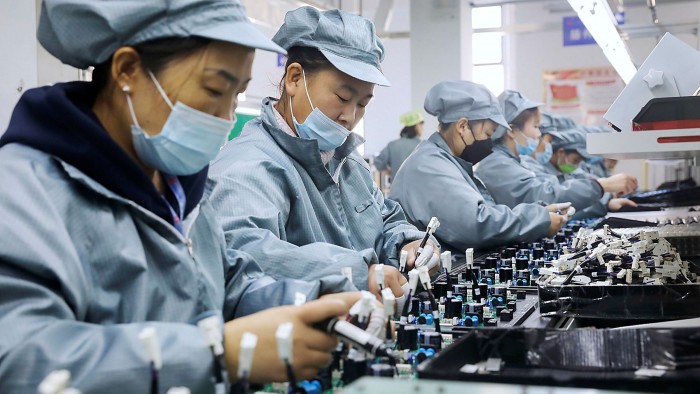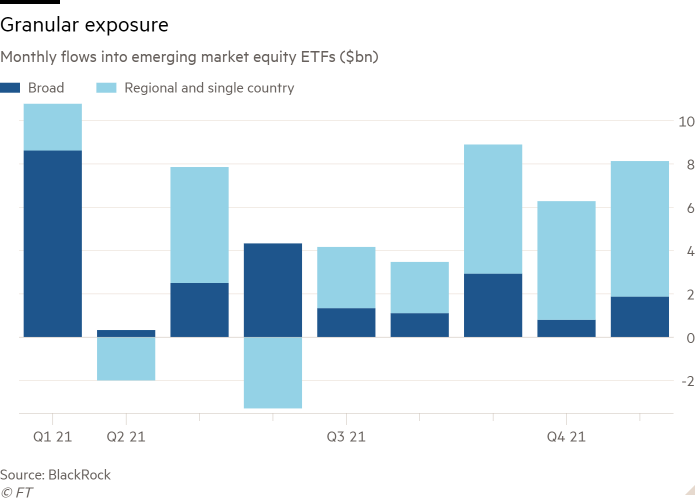Global investors pump money into Chinese equity ETFs

Roula Khalaf, Editor of the FT, selects her favourite stories in this weekly newsletter.
Interested in ETFs?
Visit our ETF Hub for investor news and education, market updates and analysis and easy-to-use tools to help you select the right ETFs.
Investors are pumping money into exchange traded funds focused on Chinese equities despite jitters over Chinese government interventions which have rattled a number of stocks and sectors this year.
President Xi Jinping’s “common prosperity” agenda has wiped more than $1tn from the market value of Chinese equities since February as a series of regulatory blows have targeted sectors from video games and technology to property and education.
Yet three China-focused ETFs, ChinaAMC MSCI China A 50 Connect, E Fund MSCI China A 50 Connect ETF and China Universal MSCI China A 50 Connect ETF, were among the top 15 globally for net inflows in November, according to ETFGI, a London-based consultancy, pulling in a combined $4.6bn.
More strikingly still, KraneShares CSI China Internet ETF (KWEB) has seen $7.8bn of net inflows since mid-February, more than twice as much as any other US-listed thematic ETF, according to Goldman Sachs.
Some now see opportunities in the beaten-up Chinese equity market, which is down by a third from its February peak in dollar terms.
“We are modestly positive on Chinese equities. We think the equity risk premium compensates investors for the risk. In other words, they are cheap,” said Karim Chedid, head of investment strategy for iShares in the Emea region.
“Chinese equities are still under-represented in the global indices and the direction is going to continue to be upward. Now might be a good time to allocate on a long-term view,” he added.
Jose Garcia-Zarate, associate director, passive strategies research at Morningstar said the outlook looked attractive for investors. “The growth picture in China is rebounding much more quickly than other economies. That helps explain interest in the equity side.”
Matthew Bartolini, head of SPDR Americas research at State Street Global Advisors, agreed, saying “growth, while slowing, is still somewhat stronger than in developed nations”. He believed the latest inflows were partly a case of investors trying to buy the dip.
The KraneShares ETF’s asset-raising success has come despite Chinese technology companies enduring a year of regulatory turbulence in the wake of the cancellation of the $37bn initial public offering of Ant Group, Jack Ma’s online finance company, in November 2020.
KWEB’s share price has fallen 46 per cent so far this year partly as a result, yet some believe its key holdings, which include Tencent, Alibaba, JD.com, Baidu and Pinduoduo, remain integral to consumer spending in the world’s second-largest economy.
“You could argue that a third of all the retail sales in China go into companies in KWEB,” said Brendan Ahern, chief investment officer of KraneShares.
“In equities, investors see that China is becoming an asset class [in its own right],” he added pointing to similarities with what happened with Japan in the 1980s and 1990s when it bifurcated, in the eyes of many investors, from the wider Asia-Pacific region.
Strong demand for Chinese equity ETFs has been mirrored by that for the country’s bond ETFs — the $12.1bn iShares China CNY Bond Ucits ETF (CNYB) has the second-largest fixed-income ETF in Europe just two years after its launch.

China-focused ETFs’ fortunes contrast with that of the broader emerging market universe. Data from BlackRock’s iShares arm show that flows into broad global emerging market equity ETFs have collapsed in recent months, with money instead being pumped into regional or single-country funds, led by Chinese and, perhaps more surprisingly, Brazilian funds.
“Emerging markets are seeing more permanent damage from the Covid-19-related activity drop and recession. They are not coming back like developed markets,” said Chedid. “As a broad complex it’s looking more challenging, so ETF investors are going more granular.”
He noted that Brazil “has been an underperformer”, with the MSCI Brazil index down 21.6 per cent year-to-date in dollar terms, so some investors may be betting on it bottoming out.
Bartolini was unconvinced, however, with his data showing net outflows of almost $2bn from single-country EM equity funds this year, barring the $13bn of inflows to Chinese funds.
Instead, he saw signs of strategic allocation to sectors, with $77bn pumped into largely cyclical industries such as financials, energy and real estate this year — a trend that is now showing signs of reversing with defensive sectors such as healthcare and consumer staples back in vogue as investors finally start to price in expectations of a semblance of developed world monetary tightening.
Additional reporting by Emma Boyde

Click here to visit the ETF Hub

Comments